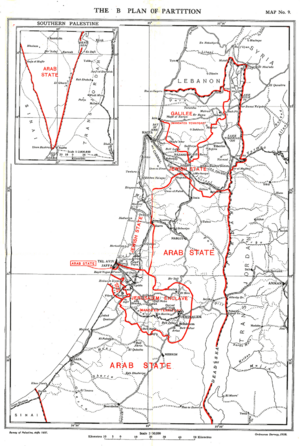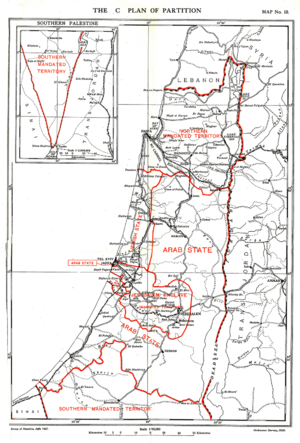Woodhead Commission facts for kids
The Woodhead Commission (also known as the Palestine Partition Commission) was a special group set up by the British government. Its main job was to suggest a detailed plan for dividing Mandatory Palestine. This included drawing new borders and looking at the money and economy of the Peel Plan.
The Commission started its work in February 1938 and finished in August 1938. They did not agree with the original Peel Commission's plan. This was mainly because it would have forced many Arabs to move. Instead, they looked at two other plans. They liked a changed version of the partition plan. This plan could work if the United Kingdom government agreed to pay a lot of money to help the Arab state. In this plan, the entire Galilee region and a path from Jaffa to Jerusalem would stay under British control.
The Commission shared its findings on November 9, 1938. After this, the British government decided not to divide Palestine right away. They said it would cause too many "political, administrative and financial difficulties." Britain then called for a meeting in London in 1939. This meeting was for all groups involved to try and find a solution together.
Contents
What the Commission Did
After the Peel Commission report came out, Arabs started their revolt again. The British government became worried. They secretly voted against dividing Palestine in December 1937. The Woodhead Commission was officially created to carry out the Peel plan. But secretly, its real job was to find reasons not to do it.
The Commission had four members: Sir John Woodhead, Sir Alison Russell, Percival Waterfield, and Thomas Reid. They were asked to study the Peel Commission plan very closely. They had to suggest borders for the proposed Arab and Jewish areas. They also had to decide which areas would stay under British control. Plus, they needed to look at all the money and economic issues involved in dividing the land.
The Commission spent over three months in Palestine. They listened to many people in 55 meetings. No Arabs came forward to share their views directly. However, King Abdullah of Transjordan wrote to Woodhead. He supported the idea of partition and also met with the Commission in Amman.
The Commission found that an Arab state could only support itself if it "contained a large number of Jews." This was because Jewish people paid more taxes. These taxes would help the Arab state balance its budget. The Commission also suggested a customs union. This would help both the Arab and Jewish states, as the Arab state needed land for farming and the Jewish state needed it for industry.
In their report, they looked at three possible changes to the Peel Commission's plan. They called these Plan A, Plan B, and Plan C. These plans suggested creating a Jewish state, a larger Arab state, and a British zone.
Plan A
Plan A was based on the Peel Plan. Its borders were drawn more carefully. It suggested a Jewish state along the coast. It also proposed a British-controlled path from Jerusalem to the coastal city of Jaffa. The rest of Palestine would join Transjordan to form an Arab state. In this plan, Jaffa (without Tel Aviv) was part of the Arab state.
Under Plan A, the Arab state would have about 7,200 Jews and 485,200 Arabs. The Jewish state would have about 304,900 Jews and 294,700 Arabs.
Plan B
Plan B was similar to Plan A. However, it made the Jewish state smaller. It added the Galilee region to the area that would stay under British control. It also added the southern part of the region south of Jaffa to the Arab State.
In Plan B, the Jewish state would have about 300,400 Jews and 188,400 Arabs. About 90,000 Arabs and 76,000 Jews would continue to live under British rule.
Plan C
Plan C was another change. It made the Jewish State even smaller. It would only be the coastal area between Zikhron Yaakov and Rehovot. Northern Palestine, including the Jezreel Valley, and the dry southern part of Palestine would be under a separate British control. This would last until the Arab and Jewish people could agree on their future. A key part of Plan C was a customs union. This meant the Arab State, the Jewish State, and the British-controlled areas would share customs taxes.
Plan C suggested:
- A Jewish state of 1,258 square kilometers. It would be in two parts. The northern part would be a coastal strip from Tel Aviv to above Zichron Ya'acov. The southern part would be a smaller area including Rehovot. It would start with about 226,000 Jews and 54,400 Arabs.
- An Arab state of 7,393 square kilometers. This would mostly be like today's West Bank and Gaza Strip, with a wide path connecting them. The Arab state would also include the city of Jaffa. It would start with about 8,900 Jews and 444,100 Arabs.
- Three areas under British control. These included all of the Galilee (with about 77,300 Jews and 231,400 Arabs). Also, an area with Jerusalem and Lydda (with about 80,100 Jews and 211,400 Arabs). And the Negev region north of Beersheva (with about 60,000 Arabs).
What They Decided
The Commission's report came out on November 9, 1938. It said that no partition plan could truly work to create self-supporting Arab and Jewish states. However, the commission did come up with other possible plans.
The commission rejected Plan A. This was their version of the Peel Plan. They mainly rejected it because it would force many Arabs to move to reduce the number of Arabs in the proposed Jewish state. The British government had already said that forced moves were not allowed. The Commission also thought that Arabs would not move willingly. This was because Arabs felt a "deep attachment to the land." Also, they expected problems for Arab development. Second, including Galilee in the Jewish state was not a good idea. This was because "the population is almost entirely Arab." Arabs living there would likely fight against it. This would also create a "minority problem" that could cause instability in the region.
Plan B was also rejected, though one member liked it. The problem of Galilee was a big reason to reject Plan B. Putting Galilee in the Arab state would create a major security problem for the Jewish state. Keeping it under British control forever would mean the large Arab population there would not get independence. There were also big problems with Haifa, which was about half Jewish, and the area from Haifa north to the border.
The commission liked Plan C the most. This plan was a changed version of partition. It could be a good way to settle things if the United Kingdom was ready to give enough money to help the Arab State. In this plan, all of Galilee and a path from Jaffa to Jerusalem would stay under British control.
Two members of the Commission also added their own thoughts. Russell thought Plan B was better than Plan C. He felt it was more like the Peel Commission's plan. He also thought it would bring more peace and was fairer and more practical. Reid believed that all three plans had serious problems.
Money and the Economy
The Commission also said there were money and economic problems. They felt these problems were so big that they could not be solved. They found that they could not suggest borders that would allow an Arab State to support itself. This was true for Plan C, Plan B, and any other plan. This was unless the Arab State included many Jews whose taxes would help balance its budget. They suggested that the Arab and Jewish states should not control their own money. Instead, the UK government should accept "very considerable financial liability." This meant they should provide enough money to help the Arab State balance its budget.
Sir John Woodhead explained his findings. He said there were two reasons why an Arab state would struggle financially. First, Jewish citizens in Palestine paid much higher taxes per person than Arabs. But any possible partition plan would leave few Jews in the Arab state. Second, most of the Arab wealth was in areas that would become part of the Jewish state. This was because these areas had many Jewish people. For example, Arabs and Jews had about the same amount of land for growing citrus fruits. But less than one-third of the Arab-owned land would be in the Arab state.
The Commission suggested a different kind of partition called "economic federalism." In this plan, the two states would share a customs union with the areas still under British control. The British authorities would then decide how to handle taxes. The report said that the British would collect customs money. After paying for shared costs, the money would be divided among the three areas. They suggested each area would get one-third at first. To help the Arab State balance its budget, it would get extra money from the British-controlled areas. This would also let it share in any growth of customs money if Palestine became more prosperous. This arrangement could also cover things like railways and mail. The Commission felt this plan could work if the British government was willing to pay a lot of money to help the Arab state.
Criticism
Former Colonial Secretary Leo Amery said that partition was rejected "for the wrong reasons." He felt the Peel Plan focused on areas where "Jews and Arabs already lived in large numbers." But he said the Mandate also required giving Jews enough land for many more people to move there. The Woodhead Commission tried to include the fewest Arabs in Jewish areas and vice versa. This led to plans that could not work. Also, it seemed to suggest that a self-supporting Arab state should "continue to enjoy those benefits that Jewish efforts and taxes had brought to all of Palestine." Amery believed no plan could work with these ideas.
What Happened Next
The Woodhead Commission's report was given to Parliament and made public on November 9, 1938. Because of this, the government announced that "the political, administrative and financial difficulties" of creating separate Arab and Jewish States in Palestine were too great. They said this solution was not practical.
The Jewish Agency Executive replied that the Woodhead report could not "serve as the basis for any negotiations." This meant they would not use it for talks between Jews and Arabs, or between the Jewish Agency and the British government.
Even though Britain said the plan was not practical, they suggested that Arabs and Jews might still agree. In 1939, London invited the Palestine Arabs, the nearby Arab states, and the Jewish Agency to London. This was for a third try to solve the problem, called the St. James Conference. In the end, both Jews and Arabs rejected the ideas from this meeting.





